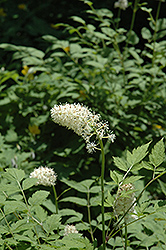Plant Height: 24 inches
Flower Height: 3 feet
Spread: 24 inches
Sunlight:
![]()
![]()
Hardiness Zone: 3
Other Names: Doll's Eye, White Cohosh
Description:
Great for woodlands and naturalized areas; flower attracts pollinators; keep soil moist but well drained; beautiful doll's eye berries are poisonous but highly ornamental
Ornamental Features
White Baneberry features showy clusters of lightly-scented white flowers rising above the foliage from early spring to early summer. It features an abundance of magnificent white berries from late summer to early fall. Its serrated compound leaves remain green in color throughout the season.
Landscape Attributes
White Baneberry is an herbaceous perennial with an upright spreading habit of growth. Its medium texture blends into the garden, but can always be balanced by a couple of finer or coarser plants for an effective composition.
This is a relatively low maintenance plant, and is best cleaned up in early spring before it resumes active growth for the season. It is a good choice for attracting birds and bees to your yard. It has no significant negative characteristics.
White Baneberry is recommended for the following landscape applications;
- Mass Planting
- Border Edging
- General Garden Use
- Groundcover
- Naturalizing And Woodland Gardens
Planting & Growing
White Baneberry will grow to be about 24 inches tall at maturity extending to 3 feet tall with the flowers, with a spread of 24 inches. Its foliage tends to remain dense right to the ground, not requiring facer plants in front. It grows at a medium rate, and under ideal conditions can be expected to live for approximately 10 years. As an herbaceous perennial, this plant will usually die back to the crown each winter, and will regrow from the base each spring. Be careful not to disturb the crown in late winter when it may not be readily seen!
This plant does best in partial shade to shade. It does best in average to evenly moist conditions, but will not tolerate standing water. It is not particular as to soil pH, but grows best in rich soils. It is somewhat tolerant of urban pollution. This species is native to parts of North America, and parts of it are known to be toxic to humans and animals, so care should be exercised in planting it around children and pets. It can be propagated by division.
